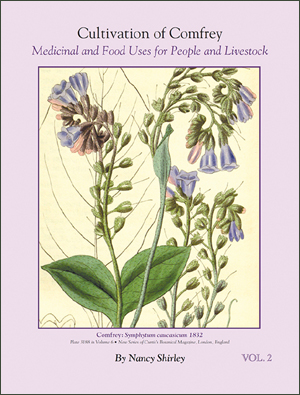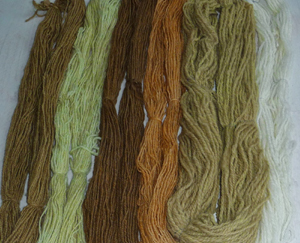
"A Trial
of Comfrey Plant Dye on Wool with Alum, Iron and Copper Mordants:
The results
are greenish - more so than the photo has picked up. From the left, copper
+ comfrey next to an undyed copper premordanted skein. In the middle, iron
+ comfrey next to an undyed iron premordanted skein and on the right, the
alum skeins. Comfrey on alum mordant gave the most herbal green."
http://wooltribulations.blogspot.com/2014/06/a-trial-of-comfrey-plant-dye-on-wool.html
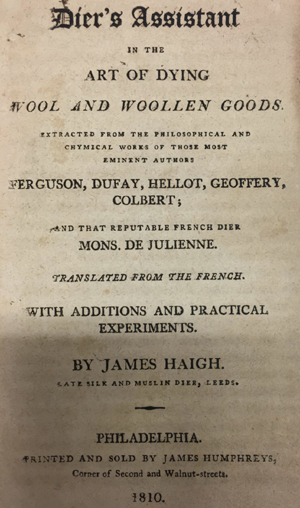
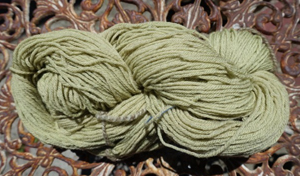
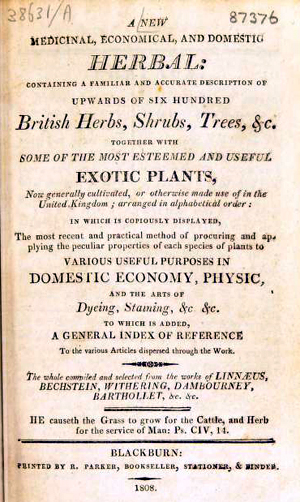
If you have experience using Comfrey as a dye, please let me know. I can add your knowledge and photos to this page. -Nancy
"Thx Nancy
Shirley this page helps a ton to me who is doing a research before I start
my comfrey business, and books that are listed there are fantastic source
of information in all areas that I plan to use it." -Nikola, Croatia
|
Comfrey
is a Natural Dye
“Common
Comfrey: A decoction of the stalks with leaves and flowers, gives to wool
prepared by a solution of bismuth, a fine and permanent brown colour. But
the most useful part of the Comfrey, is its viscid (sticky) and mucilaginous
root, which may be classed among the neglected treasures of the vegetable
kingdom. These roots are, at present chiefly employed by colour-makers,
who, by means of a decoction made of them, extract the beautiful crimson
colour from gum-lac.”
-‘A New Medicinal Economical and Domestic Herbal Containing a Familiar and
Accurate Description of Upwards of Six Hundred of British Herbs, Shrubs
and Trees, Etc.’ selected from the works of Linnaeus, Bechstein, Withering,
Dambourney and Barthollet, published by R. Parker Stationer and Bookseller
in Blackburn, England, 1808, page 46.
(Bismuth is a chemical element with symbol Bi. It a lustrous
brownish-silver metal. It is used in cosmetics, pigments and pharmaceuticals.)
(Lac is a resinous substance secreted as a protective cover by the lac insect.
People use it to make varnish, shellac, sealing wax, and dyes.)
“Scarlet of Gum-Lacque: The red part of the gum
lacque may be used for the dieing of scarlet. I tried gum-lacque with weak
lime water, with a decoction of the heart of agaric, with a decoction of
Comfrey root, recommended in an ancient book of physic. In all these the
water leaves a part of the die, and it still passes too full of colour,
and it ought to be evaporated to get all the dye; this evaporation I wanted
to avoid, therefore I made use of mucilaginous or slimy roots, which of
themselves gave no colour, but whose mucilage might retain the colouring
parts, so that they might remain with it on the filter.
The great Comfrey root has as yet the best answered my intention:
I use it dry and in a gross powder, putting half a dram (1/2 dram = 1.84
ml) to each quart (0.94 liter) of water, which is boiled a quarter of an
hour (15 minutes). Passing it through a hair sieve immediately extracts
from it a beautiful crimson tincture. Put the vessel to digest in a moderate
heat for twelve hours shaking it seven or eight times to mix it with the
gum that remains at the bottom, then pour off the water that is loaded with
colour in a vessel sufficiently large, that three-fourths may remain empty
and fill it with cold water.
Then pour a very small quantity of strong solution of Roman alum on the
tincture; the mucilaginous or slimy die precipitates itself, and if the
water which appears on the top appears still coloured, add some drops of
the solution of alum to finish the precipitation, and this repeat till the
water becomes as clear as common water.
When the crimson mucilage or slime is all sunk to the bottom of the vessel,
draw off the clear water, and filter the remainder; after which, dry it
in the sun.
If the first mucilaginous water has not extracted all the colour of the
gum lacque, (which is known by the remaining being of a weak straw colour)
repeat the operation until you separate all the die the gum-lacque can furnish;
and as it is reduced to powder when dry, the quantity to be used in the
die is more exactly ascertained than by evaporating it to the consistence
of an extract.”
-‘The Diers Assistant in the Art of Dying Wool and Woollen Goods: Extracted
from the Philosophical and Chymical Works of Those Most Eminent Authors
Ferguson, Dufay, Hellot, Geoffery, Colbert, and that Reputable French Dier
Mons. De Julienne’ by James Haigh, Leeds, England, translated from French,
1813, pages 137-138.
“The Comfrey root has been applied to several important
purposes. A strong decoction of the plant will dye wool of a brown colour.
The beautiful crimson colour obtained from gum-lac is extracted by means
of a decoction of this root.”
-‘The British Flora Medica, or, History of the Medicinal plants of Great
Britain, Volume 1’ by Benjamin Herbert Barton and Thomas Castle, London,
England, 1838. (Symphytum officinale, pages 211-215.)
(A decoction extracts mineral salts and bitter principles
from hard material such as roots, bark, seeds and wood. It needs boiling
for at least 10 minutes and then is steeped for a number of hours.)
“Dye: The leaves of Comfrey produce a brown dye
in wood mordanted with iron.”
-Rodale’s Illustrated Encyclopedia of Herbs edited by Claire Kowalchik and
William H. Hylton. Emmaus, Pennsylvania: Rodale Press, 1998, page 105.
(A mordant sets dyes on fabrics or tissue by forming a coordination
complex with the dye which then attaches to it.)
“Boil fresh Comfrey leaves for golden fabric dye.”
-’The Complete Book of Vegetables, Herbs & Fruit’ by Biggs, McVicar and
Flowerdew. London, England: Kyle Cathie Limited, 2004, page 364.
“Now, Comfrey has revealed yet another marvellous
characteristic: it produces a soft green dye on wool. Green is said to be
a difficult colour to get with simple plant dyes.
It is generally recommended to combine a yellow plant dye with the complex
blue dyes of indigo or woad (Isatis tinctoria) to get a true green. However,
I had been looking for a way to get more muted green, and without having
to undertake the complex fermentation steps needed to extract the blue dye
present in indigo or woad.
I borrowed Jenny Dean’s ‘Wild Colour: How to Grow, Prepare and Use Natural
Plant Dyes’ * from the local library. I have been disappointed with many
books and web pages on natural dyeing, as the information is often unclear,
or they use toxic mordants.
Jenny Dean’s book is quite different: there are fantastic descriptions of
various dye extraction techniques, there is no use of the toxic mordants,
and the amount of mordant is kept to an absolute minimum.
In ‘Wild Colour’ I found a description of the use of Comfrey to produce
a soft green. I went out and harvested some Comfrey and followed the dyeing
instructions in the book with some of my alum/cream of tartar treated sock
wool.
Process steps:
Chop Comfrey leaves and flower stalks up into a pot and cover with boiling
water. Leave to steep overnight. Bring to the boil and simmer for 1 hour.
Strain solution to remove plant material. Add pre-soaked, alum/cream of
tartar-treated yarn. Keep just under a simmer for 45 minutes to 1 hour.
Rinse skein and dry. The green colour was immediately apparent on the yarn.”
-Holda’s String, www.holdasstring.com, Fleece / Fiber / Yarn, South Island,
New Zealand, November 24 2015.
(* -Wild Color: The Complete Guide to Making and Using Natural Dyes by Jenny
Dean and Karen Diadick Casselman. New York, New York: Potter Craft {part
of Random House}, 2010.)
(Skein is a loosely coiled length of yarn or thread wound
on a reel.)
“I am sure I tried dyeing wool with Comfrey a couple
of years ago, getting a beige that faded. Jenny Dean's book 'Wild Colour'
says Comfrey gives sage green. As I had 1.5 kg (3.3 pounds) Comfrey leaves,
I took out three 50 grams (0.11 pound) skeins of wool. I gave them all a
hot soak with washing up liquid and a few hot rinses, then premordanted
three skeins in a pot with a cupful of iron water added - vinegar and water
in which rusty nails had been soaking - which turned the wool a pale rusty
orange. The other three were premordanted in copper water - same vinegar
and water mix which had had bits of copper piping soaking in it for months.
These turned palest green.
The Comfrey leaves were simmered for an hour and left to cool overnight.
Next day, I simmered one skein with each mordant all together in the brown
dye bath. The results are greenish. Comfrey on alum mordant gave the most
herbal green.”
-’A Trial of Comfrey Plant Dye on Wool with Alum, Iron and Copper Mordants‘
by Fran Rushworth, Wool: Tribulations of Hand Spinning and Herbal Dyeing.
http://wooltribulations.blogspot.com, June 13 2014.
“Making Comfrey dye is easy: Simmer the Comfrey
leaves, about a grocery bag full (3.5 gallon = 13.2 liter), in about a gallon
(3.7 liter) of water for about 1/2 hour, then remove the plant material.
Submerge wet, alum mordanted wool into the bath and simmer in an iron container
for another 1/2 hour or so. Olive green should be the result.
Using brass, glass, stainless steel containers will not yield the same results;
probably a watery yellow will emerge, but who knows? Natural dyeing is more
art than science.”
-‘Plants for Dyeing: Comfrey’ by KatKnit, Dances with Wools: Knitting, Spinning,
Dyeing and Related Fiber Arts, https://danceswithwool.wordpress.com, May
31 2016.
“Local Handicraft and Other Uses for Symphytum
caucasicum M. Bieb. Boraginaceae:
Armenia: An extract of the plant can stimulate plant growth.
Azerbaijan: A dye solution is prepared from Comfrey root to obtain red and
violet color and used for dyeing wool yarn as well as products made of wool*.”
-Ethnobotany of Caucasus by Ketevan Batsatsashvili, et. al. (Chapter: Symphytum
caucasicum M. Bieb. Boraginaceae, pages 683-688). Cham, Switzerland: Springer,
2017.
(* -’Dye Plants of Azerbaijan’ by M.A. Qasimov. Baku, Azerbaijan: Azerbaijan
State Publishing House, 1980.)
|



